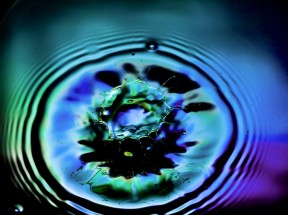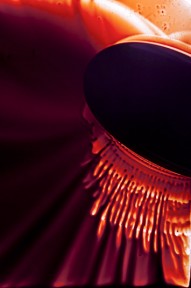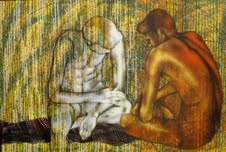I had just come back from a week-long trip when the doorbell rang. Fervently hoping it would be the home-delivery guy, I opened the door to find my 53-year-old neighbour, the good samaritan that he is, standing sheepishly with all my post. Sheepish is a trait I don’t normally associate with this effusive father of two, but one look at the top most invite in his hands and illumination dawned. Orgasm! – screamed the title of the show at both us, as I hastily took the bunch of cards off him. Well, I am no prude. I have always enjoyed a chat with artists who can unabashedly deal with sexuality in their art and break stereotypes about the human body.
Even then, I wondered what had provoked debutant photographer Sahil Mane to come up with a show with the ‘Big O’ as its pitch. A quick trip to Gallery Nvya at Saket’s Square One Mall, where Mane’s digital photographs were displayed, made me even more curious, as even though the large-size pictures – bursting with psychedelic colours and intricate patterns – have provocative titles like Shivers, Come Together, Get Set O, they are as abstract as the notion of bliss.
Mane, on his part, is candid enough to admit that anything that creates a buzz or a controversy is good for the show. “Even my 84-year-old granny was happily discussing sex at the opening of show,” beams the IT professional-turned photographer from Mumbai. “My fiancé Tara and I think alike and often discuss such issues. I feel it’s the most natural thing in the world.”
 The joy of pure communion has an intense beauty, he says and adds that it is this aura he has tried to capture in his show. Though there were concerns about how “the conservative” Delhi would react to the title, Tara was sure it was the right choice. “Look at today’s society and its mirror – the media. Testosterone-fuelled game shows, violence filled films raise less eyebrows than a humble bedroom scene,” says Tara.
The joy of pure communion has an intense beauty, he says and adds that it is this aura he has tried to capture in his show. Though there were concerns about how “the conservative” Delhi would react to the title, Tara was sure it was the right choice. “Look at today’s society and its mirror – the media. Testosterone-fuelled game shows, violence filled films raise less eyebrows than a humble bedroom scene,” says Tara.
She believes, “Love, joy, pleasure, emotion, connection” that ecstatic intimacy represents, “are still a taboo, but it’s time to celebrate all this now.”  Coming to his work, Mane has made use of as many laws of physics as he could muster to create the ecstasy behind the union, physical and spiritual. Suspending ink drops, water droplets, ferrous liquids and diluted acrylic paints into water, with laws of surface tension and viscosity on his side, he creates organic shapes of various moods and moments connected with love and its physicality.
Coming to his work, Mane has made use of as many laws of physics as he could muster to create the ecstasy behind the union, physical and spiritual. Suspending ink drops, water droplets, ferrous liquids and diluted acrylic paints into water, with laws of surface tension and viscosity on his side, he creates organic shapes of various moods and moments connected with love and its physicality.
Times have changed indeed. When about 15 years ago, Bhupen Khakar portrayed homosexuality in his autobiographical paintings, they were rejected by art galleries who didn’t want “to give the young generation bad ideas about sex”. Not so any more. Several younger artists are freely portraying various nuances of sexuality – even homosexuality and frontal nudity – in their works and being accepted by mainstream art collectors and gallery owners.
Mumbai-based Chintan Upadhyay was perhaps one of the first artists to try the forbidden when he sat nude for an installation piece in Baroda in 2005. “There is far more acceptance for such works because people are comfortable discussing sexual preferences. What was considered taboo before has come out in the public domain.” Upadhyay has been fearless about showing sexuality in his works. Whether it was caricatures of phallic symbols, inspired by the overriding masculinity he found in Northern India or his video performance titled ‘I Am A Slut’ at the ‘Met Fest-Masculinities in The City’ exhibition in Mumbai few years ago, his work forces us to confront our hypocrisies about sex, our bodies, consumerism, thought and visual culture.
The artist does this by using the language of advertisements, which sells products through selling sex.
Using one’s own body for sexual references somehow has become a common choice for most artists. Siliguri boy Abir Karmakar has often portrayed himself in haunting images of androgynous protagonists, placed in various expected and unexpected situations.
Karmakar’s take on the dual existence of male and female in each human being is as old as the concept of Ardha narishwara. Cross-dressing becomes a visual tool, to draw facets of female physical exploitation, especially in tabloid pin-ups. But creating sexual imagery through art is not easy. He says, “I work slowly, taking a lot of time to focus on and develop my concept, the layers of ‘sexual confusion’ that I can explore, all of it takes a lot of time.”
And that is where an artist needs to be careful. Sexuality can easily get caricaturised as pornography, nudity can give way to gimmickry. An unknown artist like Pranava Prakash became the talk of the town recently when his nude painting of Arundhati Roy was refused permission to be exhibited at Lalit Kala Akademi. This was not because nudity is frowned upon, but for its sheer misuse. Even a veteran artist like Jatin Das often admonishes those who dare to categorise his “bare figures” nudes!
Erotica may be synonymous with our Indian traditional art and miniature, but only a few contemporary artists can deal with it aesthetically.
Mumbai-based artist Tejal Shah, who makes no bones about her own homosexuality, has mostly dealt with alternate sexuality in an upfront but aesthetic manner. In a show of photographs on the transgender community of Mumbai last year, she delicately etched out the dreams and desires of the transgender who live on the fringes of society.
“Thinking about queer lives in the Indian context, I started this body of work between 2005-2006 with individuals from the transgender community from Mumbai and Bangalore. Slowly, I started speaking with individuals with whom I had developed a close relationship, asking them about their desires of how they saw themselves in a utopian world and what they would be if they had the choice. I wanted to breathe life into some of their fantasies.”
For instance, in her work titled ‘The barge she sat in, like a burnished throne/Burned on the water’, Shah has photographed Laxmi, a well known transgender and human rights activist based in Mumbai who had expressed the wish to become Cleopatra, while in ‘Southern Siren – Maheshwari’, the artist was struck by Maheshwari’s desire to become a South Indian filmstar being romanced by the hero. In ‘You too can touch the moon – Yashoda with Krishna’, Shah portrayed the transgender’s desire to become a mother by using Raja Ravi Varma’s painting ‘Yashoda with Krishna’ as a reference point.
Sexuality in art, while grabbing media attention for its sheer audacity, can also become a thing of beauty and intimacy. Though Delhi’s Shruti Chandra Gupta has used masculine and feminine forms in an affectionate embrace in her earlier works “showing the pleasure of being with one another away from the stress of urban life”, sexuality has taken a new meaning in her recent works with the man being depicted as a universal person.
“Sexuality for me is no longer about gender. But my forms are always nude since the moment you clothe them, they assume an identity.”
As for me, I am planning to lend my neighbour a copy of the Kamasutra.
Poonam Goel is a freelance journalist and has covered the arts for over 15 years. She contributes on visual arts for various newspapers, magazines and online media. More about her on Story Wallahs. Write to her @ poonamgoel2410@gmail.com






